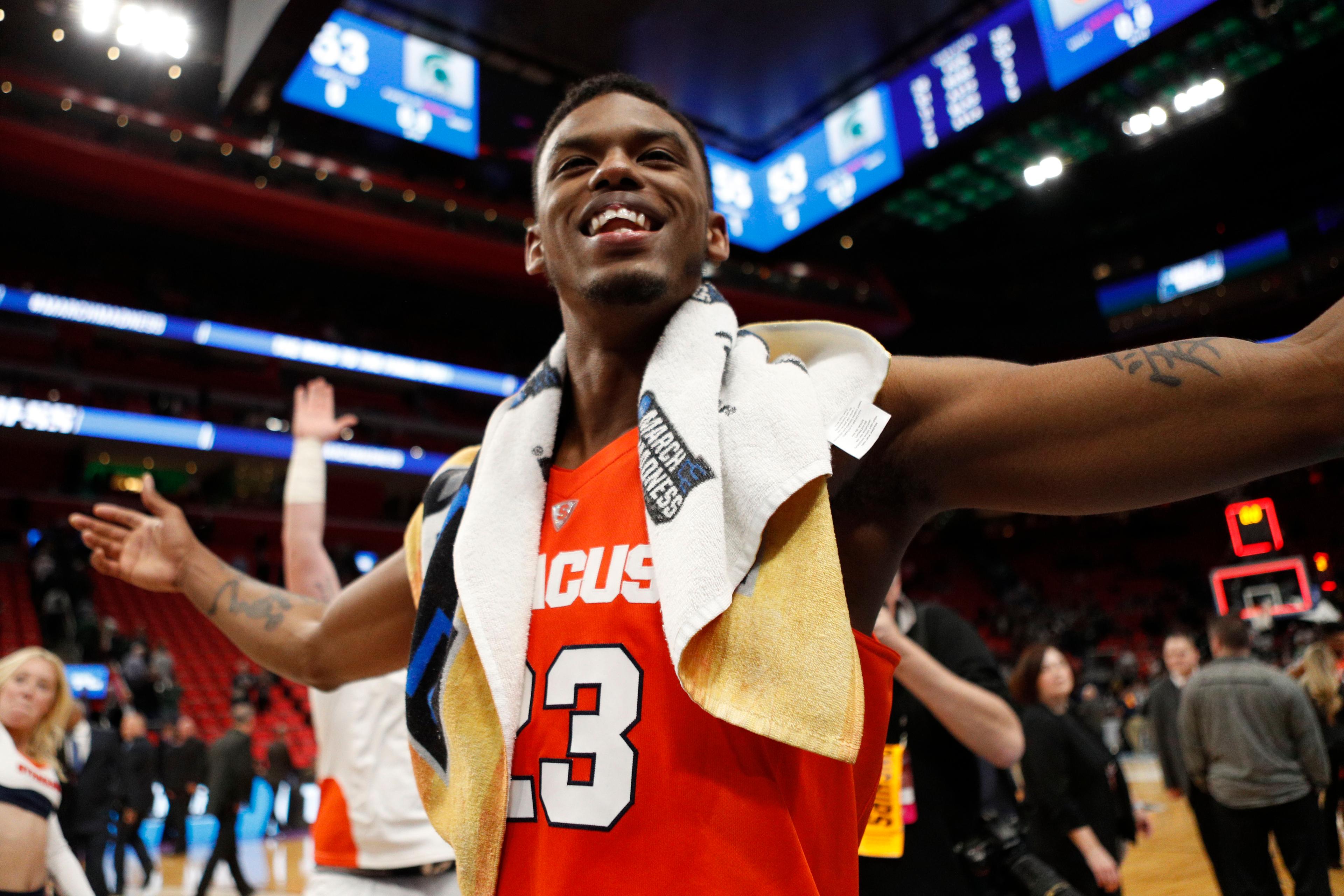When the Syracuse Zone Is Operating in Full Effect, No Team Is Safe
The Orange upset no. 3 seed Michigan State on Sunday, proving that with their unique defensive scheme, they can never be counted out in the NCAA tournament
What do you call art that’s aesthetically displeasing?
To some, Syracuse’s 2-3 zone defense is a thing of beauty—a majestic or even supernatural strategy that can elevate even the lowliest of athletes, be they freshmen or former walk-ons, to all-conference defenders. To others, watching the Orange play basketball is like watching someone cut through a porterhouse with a spoon. It’s exhausting. But when things line up just right, there’s no more effective way to take over a game.
On Sunday, Syracuse bulldozed third-seeded Michigan State in a 55-53 win that even the most devoted Orange faithful would describe as ugly. The game’s leading scorer, Syracuse’s Tyus Battle, tallied 17 points on 4-for-15 shooting. The teams combined for 42 personal fouls, 26 turnovers, and three more made free throws (35) than field goals (32). Michigan State, which entered the game with the ninth-most-efficient offense in the country, one that averaged 81 points per game this season, could muster only 53—nine fewer than its previous season low.
Syracuse frustrated the Spartans for a full 40 minutes. First-team All–Big Ten forward Miles Bridges struggled, going 4-of-18 from the field and 3-of-12 from deep, and fellow presumptive NBA lottery pick Jaren Jackson Jr. was nearly invisible, missing each of his four field goal attempts in just 15 minutes of play. And the Spartans’ plethora of experienced guards—Cassius Winston, Joshua Langford, and Matt McQuaid—looked lost taking on the Orange armada.
On a number of late possessions, the Spartans swung the ball around the perimeter, desperately hoping that one pass would open a lane for their playmakers. But apart from one jumper by forward Ben Carter late in the first half, Michigan State rarely penetrated the zone despite being blessed with two NBA-ready big men in Bridges and Jackson. Without that element to their offense, the Spartans were forced to settle for contested 3s and dangerous passes into the interior which doomed them in the end. Michigan State shot 25.8 percent from the field and 21.6 percent from 3—nearly 20 percent lower than the team’s season average from beyond the arc. And though Syracuse didn’t perform much better—35.7 percent from the field, 12.5 percent from deep—it didn’t have to. With its sixth-ranked defense operating at its peak, all Syracuse had to do was keep pace and hope for a shot or two to fall.
Syracuse head coach Jim Boeheim’s blueprint for bullying past more talented teams is simple. The Orange cut off driving and passing lanes, leaving their opponents only one option: to shoot. It’s a risky proposition. Teams that get hot from deep—which Syracuse played quite a few of this season—run circles around the Orange’s defense. But if they can close out shooters and limit long-range makes, more often than not, they’ll leave with a victory. That was the case on Sunday. It didn’t matter that Boeheim’s roster is without a projected NBA draft pick, or that their opponent had two predicted to go in the lottery. Year in and year out, Syracuse’s zone allows the team to continue marching onward.
At this point, Syracuse upsetting a higher-seeded opponent in the tournament isn’t shocking—it’s expected. In 2013, the fourth-seeded Orange took down no. 1 Indiana in the Sweet 16 en route to a trip to the Final Four. Three years later, they returned to the national semifinals—this time as a 10-seed—by dispatching top-seeded Virginia. Regardless of how poorly it’s played in the regular season, or how little NBA talent is in its rotation, Syracuse is the team that no coach wants to face in March. They’re a bizarro UVA—while the Hoos use their vaunted defensive scheme to dominate the early year but consistently fall apart in the postseason, the Orange sneak into the tournament and frustrate their foes into submission. And though their system—much like Virginia’s—is ridiculed nationally, it just keeps working. As I wrote last week when trying to determine which team was this season’s power-conference sleeper, “Playing zone might be for cowards, but it’s sure as hell better than losing.”
While Syracuse’s win over the Spartans warrants celebration, its next opponent will provide an even tougher test. Since joining the ACC prior to the 2013-14 season, the Orange have played Duke seven times, winning thrice. The two teams’ most recent meeting was just last month, when the Blue Devils overcame an abysmal shooting performance (2-of-18 from beyond the arc) to down Syracuse, 60-44, in Durham. Every stat, data point, eye test, and ounce of basic logic suggest the Devils will be able to use their own zone (a Syracuse-lite system) to force the Orange into mistakes on offense and use their cabal of highly touted guards and a dominant interior presence to blow past Syracuse in the Sweet 16. But the same was said about Michigan State heading into Sunday’s matchup.
March Madness is reaching its halfway mark, and if past tournaments have taught us anything, it’s that the only thing more surprising than a deep Syracuse run is the absence of one.